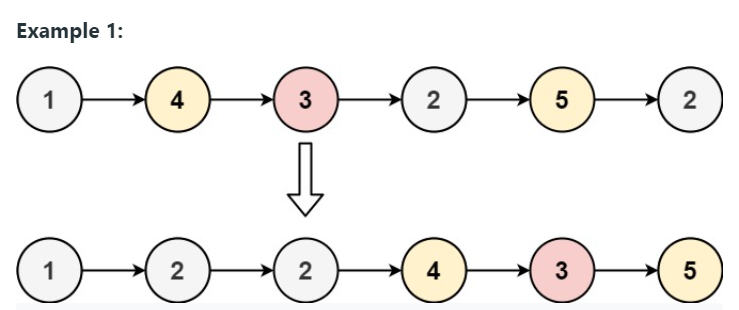Table of Contents
Problem Statement :
Partition List Leetcode Solution – Given the head of a linked list and a value x, partition it such that all nodes less than x come before nodes greater than or equal to x.
You should preserve the original relative order of the nodes in each of the two partitions.
Example :
Example 1

Input: head = [1,4,3,2,5,2], x = 3 Output: [1,2,2,4,3,5]
Example 2
Input: head = [2,1], x = 2 Output: [1,2]
Constraints :

Explanation :
- Given the head of a linked list and a value x.
- We need to partition or reorder the list so that all nodes less than x come before nodes greater than or equal to x.
- We should preserve the original relative order of the nodes in each of the two partitions.
- From the Example 1, the First partition [1 -> 2 -> 2], the Second partition [4 -> 3 -> 5].
- As we can see all the nodes that have a value less than x appear before the second partition, also the relative order is preserved on both partitions.
Intuition :
- We will make two pointers dummyOne and dummyTwo.
- These two pointers keep track of the two linked lists as described above.
- These two pointers could be used two create two separate lists and then these lists could be combined to form the desired reformed list.
- dummyOne will contain the first partition [ 1 -> 2 -> 2 ].
- dummyTwo will contain the second partition [4 -> 3 -> 5] .
- At last we will join the dummyOne and dummyTwo and return the desired reformed list [1 -> 2 -> 2 -> 4 -> 3 -> 5 ].
Algorithm :
- Initialize two pointers dummyOne and dummyTwo.
- In the algorithm, we initialize these two pointers with a dummy ListNode, because using a dummy ListNode helps us reduce the number of conditional checks and null pointer exceptions.
We will also maintain the tail node of the dummy list node, it will help us to add at the end of the dummy node.
Iterate the original linked list, using the curr pointer.
- Now
If the curr node’s value is lesser than X, then remove that node from the original list and add it at Last in the dummyOne list.
Otherwise, the node should be part of dummyTwo list. So we add that curr node in dummyTwo list at the end.
Once we are done with all the nodes in the original linked list, we would have two lists dummyOne and dummyTwo.
Now, these two lists dummyOne and dummyTwo can be combined to form the reformed list.
Code for Partition List :
Java Code
/**
* Definition for singly-linked list.
* public class ListNode {
* int val;
* ListNode next;
* ListNode() {}
* ListNode(int val) { this.val = val; }
* ListNode(int val, ListNode next) { this.val = val; this.next = next; }
* }
*/
class Solution {
public ListNode partition(ListNode head, int x) {
ListNode dummyOne=new ListNode(-1);
ListNode dummyTwo=new ListNode(-1);
ListNode tailOne=dummyOne;
ListNode tailTwo=dummyTwo;
ListNode curr=head;
while(curr!=null){
ListNode temp=curr;
curr=curr.next;
temp.next=null;
if(temp.val<x){
tailOne= addNodeAtLast(temp,tailOne);
}
else{
tailTwo= addNodeAtLast(temp,tailTwo);
}
}
tailOne.next=dummyTwo.next;
return dummyOne.next;
}
//------ Add Node At Last -------------
public ListNode addNodeAtLast(ListNode node, ListNode tail){
tail.next=node;
tail=tail.next;
return tail;
}
}C++ Code
/**
* Definition for singly-linked list.
* struct ListNode {
* int val;
* ListNode *next;
* ListNode() : val(0), next(nullptr) {}
* ListNode(int x) : val(x), next(nullptr) {}
* ListNode(int x, ListNode *next) : val(x), next(next) {}
* };
*/
class Solution {
public:
ListNode* partition(ListNode* head, int x) {
ListNode* dummyOne=new ListNode(-1);
ListNode* dummyTwo=new ListNode(-1);
ListNode* tailOne=dummyOne;
ListNode* tailTwo=dummyTwo;
ListNode* curr=head;
while(curr!=NULL){
ListNode* temp=curr;
curr=curr->next;
temp->next=NULL;
if(temp->val<x){
tailOne= addNodeAtLast(temp,tailOne);
}
else{
tailTwo= addNodeAtLast(temp,tailTwo);
}
}
tailOne->next=dummyTwo->next;
return dummyOne->next;
}
//------ Add Node At Last -------------
ListNode* addNodeAtLast(ListNode* node, ListNode* tail){
tail->next=node;
tail=tail->next;
return tail;
}
};Complexity Analysis for Partition List Leetcode Solution:
Time Complexity
O(N), where N is the number of nodes in the original linked list and we iterate the original list.
Space Complexity
O(1), we have not utilized any extra space.